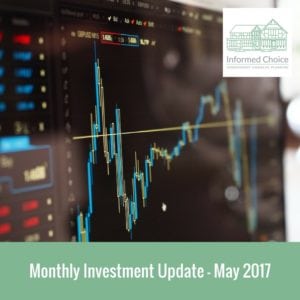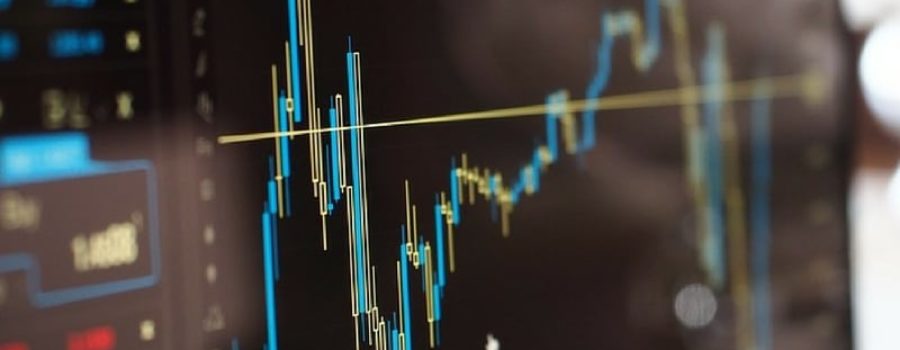 In our latest monthly investment update for May 2017, we look at how the investment markets, global economy and commodity prices are performing.
In our latest monthly investment update for May 2017, we look at how the investment markets, global economy and commodity prices are performing.
The FTSE 100 index of leading UK company shares finished April at 7,203.94, falling by 118.98 points or 1.62% during the month.
It was the biggest one month fall for the index since November. Larger UK companies have struggled following Prime Minister Theresa May’s decision to call a snap general election, which lifted Sterling and therefore reduced US dollar denominated profits for FTSE 100 firms.
Uncertainties surrounding the Brexit negotiations also continue to influence investor sentiment and a weaker than expected UK economic growth reading came through at the end of the month. Pound Sterling is expected to play less of a role for UK equities over the next year, with the currency adapting to softer economic fundamentals.
UK GDP figures released at the end of April suggest a slowdown in consumer spending, with the High Street hurt by last years’ fall in Sterling. GDP growth fell more than predicted to 0.3% in the first quarter of the year, down from 0.7% in the final quarter of 2016.
Economists expect economic growth to remain weak during the Brexit negotiations, with higher price inflation and low wage inflation hurting consumer spending. The retail sector was the biggest drag on economic growth in the first quarter, suggesting shoppers are starting to cut back.
In stark contrast to these GDP figures, the manufacturing sector is reporting healthy activity. The latest Markit/CIPS UK manufacturing Purchasing Managers’ Index (PMI) rose to 57.3 in April, up from 54.2 in March. This rise was well above the expectations of economists and represents its fastest pace of growth for three years.
Markit commented the manufacturing sector experienced “solid improvement” in April, with new orders received at the fastest rate since January 2014. The survey also found the main source of new work was the UK domestic market, but a “solid increase in new export business” was reported due to better global economic conditions and a weaker pound.
In the US, the latest economic figures also indicate a consumer slowdown. The Commerce Department reported GDP growth of 0.7% in the first quarter, following growth of 2.1% in the final quarter of last year. This was the weakest quarter in three years, coming as President Trump celebrates his first 100 days in the White House.
The US economic slowdown in the first quarter was largely driven by slower spending. This grew by 0.3% in the first quarter after growth of 3.5% in the previous quarter. Another factor to blame was an unusually warm winter, which resulted in lower spending on utility bills.
Any slowdown in the US economy is expected to be temporary, with economists forecasting 3% or better growth in this quarter.
Turning to Japan, price inflation remains elusive and has only risen by 0.1% compared to a year earlier. Economic growth is an annualised 1.2%, suggesting the stimulus measures put forward by Prime Minister Abe have been having some impact. There is also very low unemployment at 2.8%, which represents a 22 year low.
UK house prices fell again in April, with rising price inflation and low wage growth contributing to a slower market. The latest Nationwide survey reported the average price of a home fell by 0.4% during the month, resulting in an average price of £207,699. This was the second consecutive monthly house price fall reported by the lender.
As a result, the annual rate of house price growth slowed to 2.6%. This is its weakest level of annual growth since June 2013. Nationwide said their outlook for the property market was difficult to predict due to the upcoming general election and Brexit uncertainty.
Price inflation in the UK remained steady last month, with the Consumer Prices Index (CPI) measure staying at 2.3% for the year. Higher prices for food and clothing were offset by falling prices for air fares, due to the timing of Easter. The new preferred inflation measure of CPIH, which contains an element of housing costs, also stayed unchanged at 2.3% in March.
The Bank of England celebrates 20 years of independence this week. With the return of price inflation, some commentators are suggesting it should respond with higher interest rates. Balanced with this is the need to address the economic slowdown and uncertainty ahead.
The benchmark 10 year UK Gilt yield stands at 1.111% at the start of May, falling slightly during April.
£1 buys $1.29100 or €1.18320. The Forex Gold Index is $1,266.45/oz and the Silver Index is $17.41/oz. Brent Crude Oil Spot is currently $54.90/barrel.

